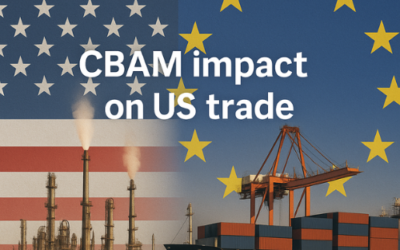This new brief from Sandbag sets out why expanding the scope to cover chemicals, polymers and refinery products is a critical and achievable next step for the CBAM.

The European Commission is reviewing whether more products should be brought into the scope of the Carbon Border Adjustment Mechanism (CBAM). Sandbag’s latest brief makes the case for expanding the CBAM to include organic chemicals, polymers, and refinery products — a significant gap in the current coverage.
About the brief
The objective of the CBAM is to prevent carbon leakage as free allocation under the EU ETS is phased out. While some key products like steel, aluminium and fertilisers are already covered, most chemicals remainexcluded — despite chemical plants and refineries accounting for about 30% of EU ETS industry emissions.
This policy brief explains why including more chemicals in the CBAM is necessary, and how key value chains can be covered initially, with a phased and targeted expansion of coverage over time.
Key findings
- Free allocation under the EU ETS is not fit for purpose – it creates market distortions and discourages investment in low-emission alternatives.
- The chemical and refinery sectors received 163 million free allowances in 2023, worth approximately €13 billion, yet the EU chemicals sector suggests carbon leakage is still taking place
- CBAM inclusion would create a more level playing field with carbon-intensive imports while providing better incentives for reducing emissions in the EU
- The complexity of the sector should not be considered an obstacle – initially the focus should be on including key value chains, with expansion of coverage over time
- Starting with key basic organic chemicals, their downstream polymers and upstream refinery products would be the simplest approach that would enable the phase out of most free allocation, while preventing avenues for circumvention.
Related publications
The EU CBAM: a two-way street between the EU and Africa
Sandbag’s newly released CBAM Simulator allowed us to explore how the EU’s Carbon Border Adjustment Mechanism (CBAM) could impact African exporters — and how cleaner production and carbon pricing could turn a cost into a competitive edge.
CBAM impact on US trade: an analysis
Sandbag’s September 2025 research note explores the impact of the EU’s CBAM on US exports. It finds that even with expanded scope, the financial impact remains marginal — and US carbon pricing could turn net costs negative.
The EU CBAM: A Two-Way Street to Climate Integrity?
Sandbag’s latest report examines how the EU’s CBAM will impact third country exporters. While some may reduce costs through resource shuffling, real emissions may remain unchanged — calling for stronger alignment through carbon pricing.



